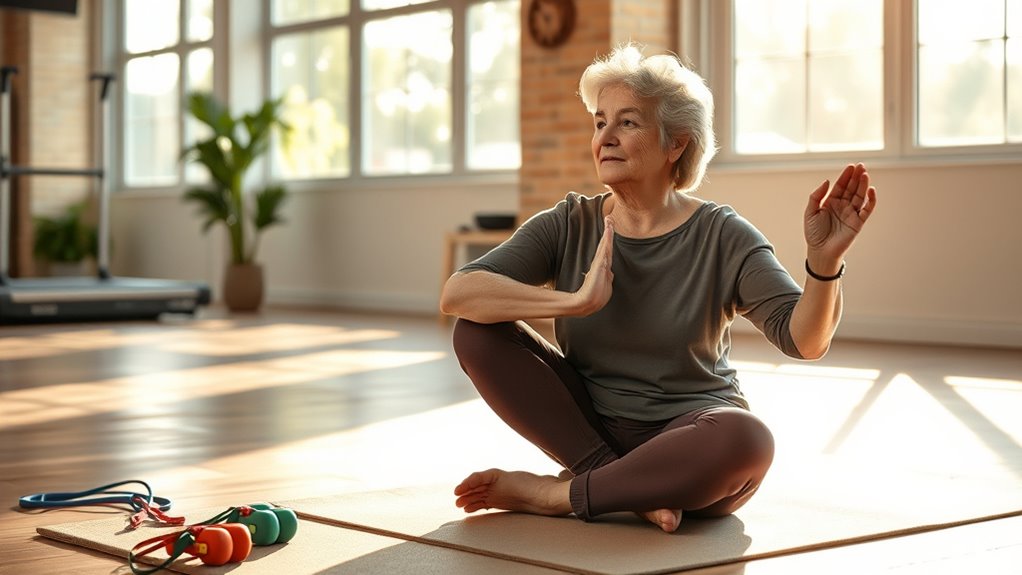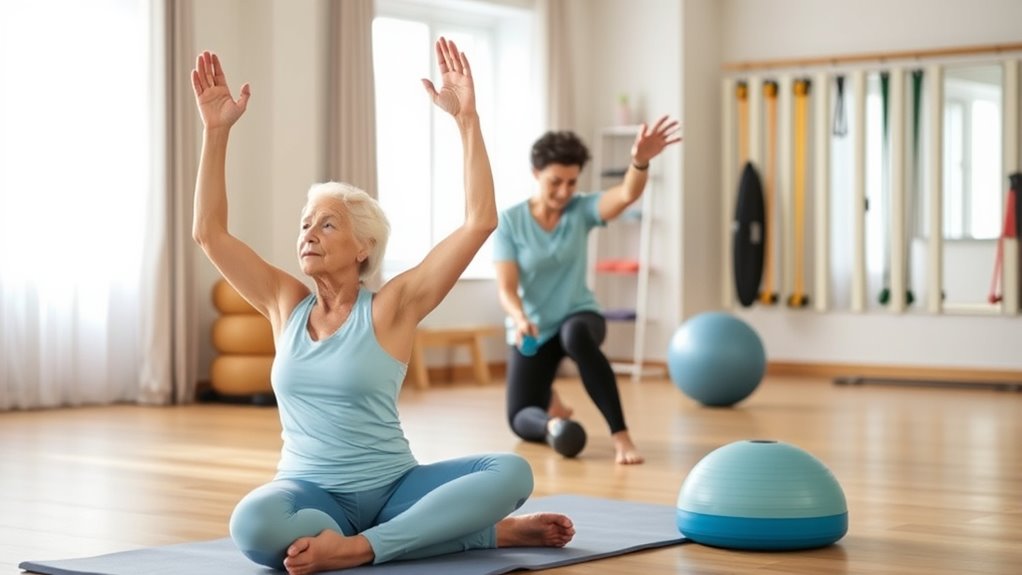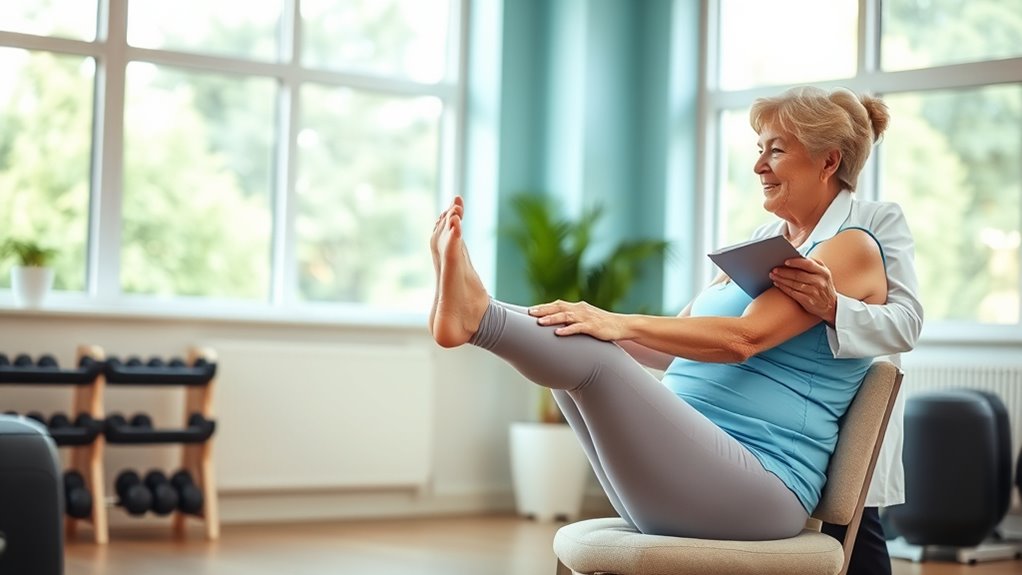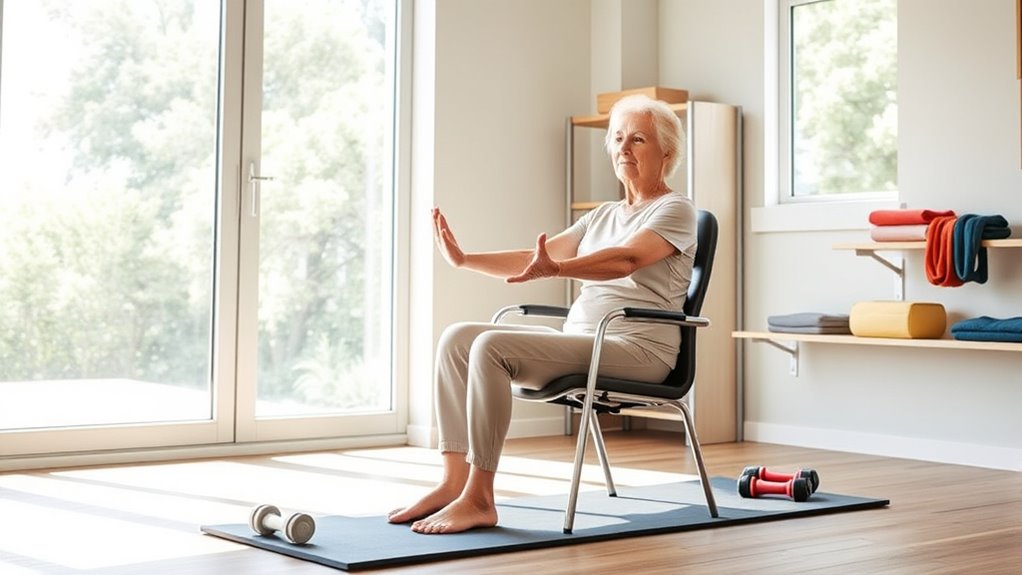To safely exercise with fragile bones, focus on low-impact activities like walking, swimming, or tai chi that support bone health without risking fractures. Incorporate gentle strength and balance exercises, using proper technique and gradual progressions to prevent injury. Create a safe environment free of hazards, and listen to your body during activities. Staying active can improve your strength, balance, and overall well-being—continue exploring to discover effective routines tailored for your needs.
Key Takeaways
- Engage in low-impact weight-bearing activities like walking, swimming, or tai chi to support bone health safely.
- Focus on gentle, controlled exercises that improve balance and strength without risking fractures.
- Use supportive environments with non-slip surfaces, grab bars, and appropriate footwear to prevent falls and injuries.
- Consult healthcare providers before starting new routines and monitor your body’s responses regularly.
- Incorporate balance and flexibility exercises to reduce fall risk and enhance skeletal stability gradually.
Understanding Osteoporosis and Exercise Safety

Because osteoporosis weakens your bones, understanding how exercise affects this condition is crucial for safety, it’s important to choose activities that strengthen bones without risking fractures. High-impact exercises or activities that involve sudden movements can increase your fracture risk. Instead, focus on weight-bearing exercises like walking or low-impact activities such as swimming and tai chi, which promote bone health safely. Incorporating bone-strengthening exercises into your routine can further support skeletal health. Additionally, maintaining proper posture can help reduce undue stress on fragile bones. Proper technique and gradual progression help prevent injury. Regularly practicing posture correction techniques can enhance balance and stability, reducing fall risk. Always listen to your body and avoid overexertion. Consulting with your healthcare provider before starting any new exercise routine is essential, especially if you have severe osteoporosis. Proper technique and gradual progression help prevent injury. Remember, the goal is to build strength and maintain mobility without putting undue stress on fragile bones. Incorporating space optimization techniques can help create a safe and comfortable environment for exercise routines. Your safety depends on making informed, cautious choices.
Benefits of Staying Active With Fragile Bones

Staying active with fragile bones can help increase your bone density and make your bones stronger over time. It also improves your balance and strength, reducing the risk of falls and fractures. Plus, regular activity can boost your mental well-being, helping you feel more positive and confident. Incorporating gentle exercises like weight-bearing activities can further support bone health and resilience.
Enhances Bone Density
Engaging in weight-bearing exercises can substantially boost bone density, which is essential for individuals with osteoporosis. When you put stress on your bones through activities like walking, dancing, or low-impact aerobics, you stimulate bone cells to grow stronger. This process helps slow bone loss and may even promote new bone formation. Regular activity increases calcium absorption and improves your bone’s structural integrity over time. Staying active not only enhances bone density but also supports overall skeletal health, reducing the risk of fractures. Consistency is key; even moderate, weight-bearing routines performed regularly can make a significant difference. By making movement a part of your daily routine, you actively contribute to maintaining and improving your bone strength despite fragile bones.
Improves Balance & Strength
Even with fragile bones, staying active can markedly improve your balance and strength. Regular movement helps strengthen the muscles that support your bones, reducing the risk of falls. Exercises like gentle weight-bearing and resistance training target key muscle groups, enhancing stability and coordination. Better balance means you’re less likely to stumble or lose footing, which is vital for osteoporosis management. Strengthening your core, legs, and hips provides a solid foundation, making daily activities easier and safer. Consistent activity also improves your posture, further supporting your skeletal health. Remember to start slow and focus on controlled movements. Over time, these exercises build resilience, helping you maintain independence and reduce fracture risks. Staying active is an essential part of managing osteoporosis effectively.
Boosts Mental Well-being
Maintaining physical activity not only strengthens your muscles and bones but also substantially boosts your mental well-being. Regular movement releases endorphins, natural mood lifters that help reduce stress and anxiety. When you exercise, you create a sense of accomplishment, which can improve your confidence and outlook. Staying active also provides social opportunities, whether you’re walking with a friend or joining a gentle class, helping you feel connected and less isolated. Additionally, exercise can improve sleep quality, making you feel more refreshed and alert during the day. For those with fragile bones, safe and appropriate activities guarantee you gain these mental health benefits without risking injury. Overall, staying active supports a healthier mind alongside a stronger body, enhancing your overall quality of life.
Low-Impact Aerobic Activities for Bone Health

Low-impact aerobic activities are great for boosting your bone health without putting too much strain on your joints. You might consider gentle cardio options like brisk walking or low-impact dance moves to stay active safely. Aquatic exercises also offer buoyant support, making them an excellent choice for gentle, bone-strengthening workouts. Incorporating safe exercise routines such as secure device use can help protect your personal health data while staying active.
Gentle Cardio Options
Since high-impact exercises can be risky for those with osteoporosis, incorporating gentle cardio options is a smart way to boost bone health without undue stress. Low-impact activities like walking, swimming, and using a stationary bike improve cardiovascular health while minimizing joint strain. These exercises increase circulation and stimulate bone maintenance without risking fractures or falls. You can start with short sessions and gradually increase duration as your strength improves. Focus on steady, controlled movements to protect fragile bones. Consistency is key—aim for at least 150 minutes of moderate activity weekly. Remember to wear supportive shoes and listen to your body. Gentle cardio not only supports bone health but also enhances overall well-being, helping you stay active and confident.
Low-Impact Dance Moves
Incorporating gentle dance moves into your routine offers a fun and effective way to support bone health without the risks associated with high-impact exercises. These low-impact moves, like side steps, gentle twirls, or simple step touches, can be easily adapted to your fitness level. You don’t need special equipment—just enough space to move comfortably. Dancing boosts circulation, improves coordination, and encourages weight-bearing activity, which benefits your bones. Focus on controlled movements and proper posture to prevent strain. Consistency is key; aim for short sessions a few times a week. By making dance a regular part of your routine, you’ll enjoy a lively, bone-strengthening activity that’s safe and enjoyable. Plus, it lifts your mood and keeps you motivated to stay active.
Aquatic Exercise Benefits
Aquatic exercise offers an excellent way to engage in weight-bearing activity without putting stress on your joints. The buoyancy of water supports your body, reducing impact while still providing resistance to strengthen bones and muscles. This makes it ideal for those with fragile bones, arthritis, or joint pain. Water-based activities improve cardiovascular health, enhance flexibility, and boost balance—all vital for osteoporosis management. Plus, the cool environment helps keep you comfortable during workouts. By incorporating aquatic exercises into your routine, you can stay active safely and reduce fall risk.
- Low-impact resistance training
- Improved joint flexibility
- Enhanced core stability
- Increased cardiovascular endurance
Strengthening Exercises Without Strain

To strengthen your bones without risking strain, focus on gentle, controlled exercises that emphasize proper form. Start with low-impact movements like seated leg lifts or wall push-ups, which minimize stress on your bones and joints. Use slow, deliberate motions to engage your muscles safely. Incorporate resistance bands or light weights gradually, paying attention to your body’s signals. Avoid jerky or sudden movements that could cause injury. Consistency is key; perform these exercises regularly, but don’t overdo it. Remember to breathe steadily and maintain good posture throughout. If you feel any pain or discomfort, stop immediately. Prioritizing controlled, mindful movements helps build strength without overloading fragile bones, supporting your overall bone health safely. Regularly reviewing your exercise routine can help ensure it remains effective and safe as your fitness level changes. Incorporating bone-strengthening activities into your routine can further enhance your results. Additionally, focusing on proper technique ensures you maximize benefits while minimizing potential risks to your delicate bones. Engaging in weight-bearing exercises when appropriate can also promote bone density without undue stress. Including balance and stability training can help prevent falls and related fractures, further protecting fragile bones.
Balance and Flexibility Routines to Prevent Falls

Building on your strength exercises, focusing on balance and flexibility can markedly reduce the risk of falls. These routines improve your stability and help you recover from slips or uneven surfaces. Incorporate gentle movements that stretch tight muscles and enhance coordination. Simple practices like standing on one foot or gentle neck stretches can make a big difference. Consistency is key to maintaining progress and preventing falls over time. Incorporating balance-focused exercises such as Tai Chi or yoga can further enhance stability. Perform ankle circles to strengthen stabilizing muscles
Tips for Creating a Safe Exercise Environment

Creating a safe exercise environment is essential to prevent falls and injuries, especially for individuals with osteoporosis. Start by choosing a well-lit, clutter-free space free from tripping hazards like loose rugs or cords. Use sturdy, non-slip mats or flooring to provide stability and cushioning. Guarantee your exercise area has good ventilation and appropriate room temperature to keep comfortable. Keep all necessary equipment within reach to avoid unnecessary movement during workouts. Wear supportive shoes with good grip to prevent slipping. If you’re exercising at home, consider installing grab bars or handrails in areas prone to falls, like near the bathroom or stairs. Regularly check your surroundings for hazards, and always prioritize safety over intensity. Creating a secure space boosts confidence and ensures a safer exercise experience.
Monitoring Progress and When to Seek Guidance

Monitoring your progress is key to guaranteeing your exercise routine remains effective and safe. Regularly check how you feel during and after workouts to identify improvements or signs of overexertion. Keep track of your strength, balance, and flexibility milestones to stay motivated. If you notice persistent pain, dizziness, or worsening symptoms, it’s time to seek guidance from a healthcare professional. Staying attentive helps prevent injuries and ensures you’re on the right track.
Remember to consult your doctor before making significant changes to your routine. Consider scheduling periodic assessments with a physical therapist or fitness expert trained in osteoporosis. Staying vigilant about your progress guarantees you exercise safely and effectively, reducing risks and supporting your bone health.
Frequently Asked Questions
How Often Should I Exercise to Improve Bone Strength Safely?
You should aim to exercise about three to five times a week to safely improve your bone strength. Incorporate weight-bearing and muscle-strengthening activities, but avoid overdoing it to prevent injury. Listen to your body and start with moderate intensity, gradually increasing as you feel more comfortable. Consistency is key, so find routines you enjoy and can stick to regularly for ideal results.
Are There Specific Exercises I Should Avoid With Osteoporosis?
You should avoid high-impact activities like jumping, running, or heavy weightlifting, which can put too much strain on your fragile bones. Instead, focus on low-impact exercises such as walking, swimming, or gentle strength training, which help improve bone health without risking fractures. Always listen to your body, and consult your healthcare provider before starting new exercises to guarantee they’re safe for your condition.
Can Exercise Help Reverse Osteoporosis or Just Prevent Further Loss?
They say “prevention is better than cure,” and with osteoporosis, exercise mainly prevents further bone loss. While it can’t fully reverse existing damage, regular weight-bearing and resistance exercises can strengthen your bones, improve balance, and reduce fracture risk. You won’t turn back the clock completely, but staying active helps maintain your current bone density and keeps you stronger longer. So, keep moving—your bones will thank you.
What Signs Indicate I Should Stop Exercising Immediately?
You should stop exercising immediately if you experience sharp or sudden pain, dizziness, chest discomfort, or shortness of breath. If you notice any unusual weakness, joint or muscle pain that worsens, or if you feel faint or dizzy, it’s vital to pause and seek medical advice. These signs can indicate injury or other health issues, so listening to your body and prioritizing safety is essential during exercise.
How Can I Stay Motivated to Exercise Regularly With Fragile Bones?
You might worry about pushing yourself too hard, but staying motivated is key. To keep going, set small, achievable goals and celebrate each milestone. Find activities you enjoy, like gentle walking or yoga, which suit your fragile bones. Remember, consistency beats intensity. Track your progress, and consider exercising with a friend for encouragement. Staying positive and patient helps you build a routine that feels rewarding and safe.
Conclusion
By incorporating these safe exercises into your routine, you’re taking essential steps toward stronger bones and better balance. But remember, every journey has its moments of challenge and discovery. Will you push through the uncertainty and stay committed? The path to improved bone health isn’t always smooth, but with patience and care, you can open a future where strength and confidence grow—one careful step at a time. Are you ready to begin?









